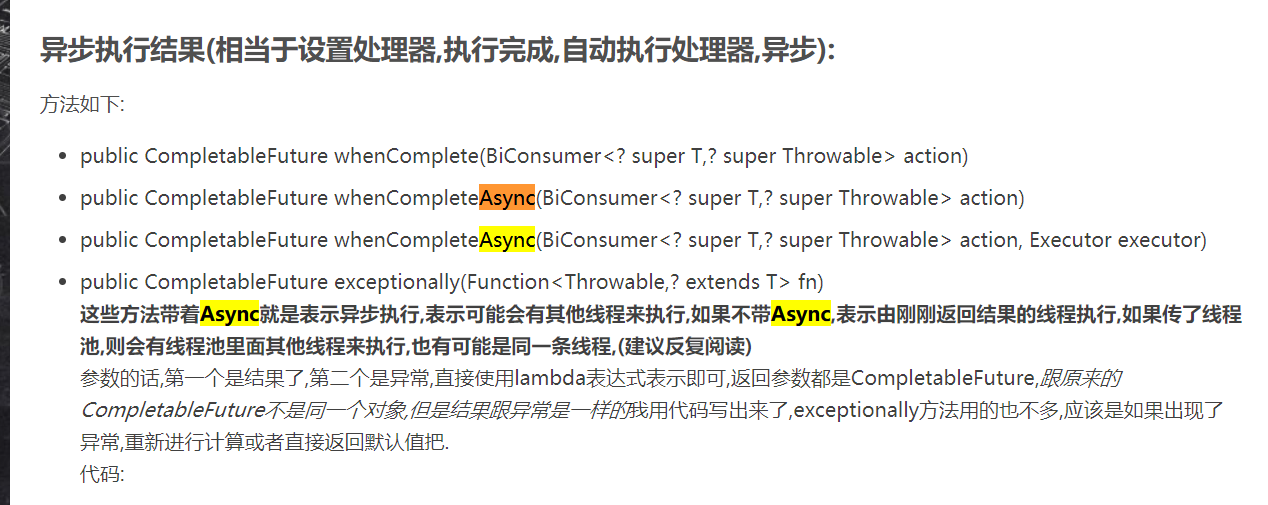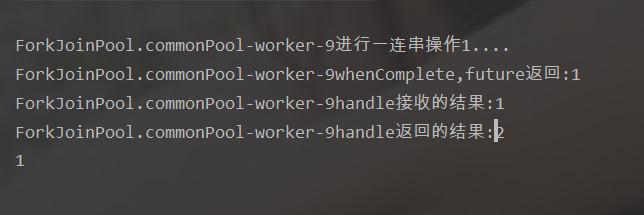handle 方法和whenComplete方法类似,

如果是方法后面加了Async表示异步执行,就是从ForkJoinPool.commonPool-worker线程池里里面重新选择线程,可能是同一个线程,可能不是同一个线程,如果没有加,就代表使用返回当前结果的线程执行…
1. 接收参数不同

whenComplete接收的是BiConsumer,handler接收的是BiFunction;
顾名思义,BiConsumer是直接消费的,而BiFunction是有返回值的,
BiConsumer没有返回值,而BiFunction是有的;
BiConsumer,BiFunction区别
2. 返回参数不同
一个是返回传进去的值,一个是返回处理返回的值
handler接收的是一个 BiFunction<? super T,Throwable,? extends U> fn 类型的参数,因此有 whenComplete 方法和 转换的功能 (thenApply)
写一个简单的测试:
@Test
public void test3() throws Exception {
CountDownLatch countDownLatch = new CountDownLatch(1);
CompletableFuture<Integer> future1 = CompletableFuture.supplyAsync(() -> {
System.out.println(Thread.currentThread().getName() + "进行一连串操作1....");
try {
TimeUnit.SECONDS.sleep(3);
} catch (InterruptedException e) {
e.printStackTrace();
}
return 1;
});
//whenComplete方法,返回的future的结果还是1
CompletableFuture<Integer> future = future1.whenComplete((x, y) -> {
try {
TimeUnit.SECONDS.sleep(3);
} catch (InterruptedException e) {
e.printStackTrace();
}
System.out.println(Thread.currentThread().getName() + "whenComplete,future返回:" + x);
});
//handler返回的future结果是字符串"2"
CompletableFuture<String> handle = future.handle((x, y) -> {
System.out.println(Thread.currentThread().getName() + "handle接收的结果:" + x);
countDownLatch.countDown();
return "2";
});
CompletableFuture<Integer> handle1 = handle.handle((x, y) -> {
System.out.println(Thread.currentThread().getName() + "handle返回的结果:" + x);
countDownLatch.countDown();
return 2;
});
countDownLatch.await();
System.out.println(1);
}
执行的结果:

说到底,handle 方法和whenComplete方法的区别主要是Consumer,BiConsumer和Function,BiFunction的区别
最后
以上就是勤奋凉面最近收集整理的关于CompletableFuture handle和whenComplete区别的全部内容,更多相关CompletableFuture内容请搜索靠谱客的其他文章。
本图文内容来源于网友提供,作为学习参考使用,或来自网络收集整理,版权属于原作者所有。








发表评论 取消回复